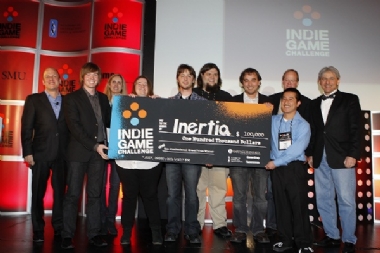Video Game Designed by Evan Skarin '09 Takes Top Award in Prestigious Indie Challenge
February 14, 2011
 February 14, 2011, Greencastle, Ind. — A team of developers led by Evan M. Skarin, a 2009 graduate of DePauw University, was one of two "big winners of the second annual Indie Game Challenge," notes an announcement. Skarin's Team Hermes and their video game, Inertia, were honored Friday named on the closing night of the annual D.I.C.E.™ (Design, Innovate, Communicate, Entertain) Summit at the Red Rock Resort & Casino in Las Vegas.
February 14, 2011, Greencastle, Ind. — A team of developers led by Evan M. Skarin, a 2009 graduate of DePauw University, was one of two "big winners of the second annual Indie Game Challenge," notes an announcement. Skarin's Team Hermes and their video game, Inertia, were honored Friday named on the closing night of the annual D.I.C.E.™ (Design, Innovate, Communicate, Entertain) Summit at the Red Rock Resort & Casino in Las Vegas.
Skarin, who was a psychology major and Information Technology Associate at DePauw, was leader of the team that created Inertia and was responsible for level design and art. He and other members of Team Hermes were December 2010 graduates of the master's degree program in video game design at The Guildhall at Southern Methodist University (SMU). The team received $130,000 in cash and prizes.
Inertia, which is available through Xbox Live Indies for $1, won in the "non-professional" category and also took awards for technical achievement, achievement in gameplay and "gamer's choice." According to SMU, "A total of 90 individuals selected by the Academy of Interactive Arts & Sciences (AIAS) served as judges for the competition -- all professional game designers with groundbreaking titles on their résumés."
Skarin and two Hermes teammates have started Inertia Studios.
The team won $130,000 in cash and prizes for their efforts. (photo: Skarin, at left and holding the check, celebrates with his teammates Friday night)
celebrates with his teammates Friday night)
"Inertia features an innovative mechanic that allows players to suspend gravity and use inertia to bounce off walls, float through space, and move through the game's environment -- a decaying space station on the brink of collapse," notes SMU (learn more here).
Skarin says, "Since Inertia was developed at SMU, without a doubt the hardest part about making it was finding the time to balance between working on the game as a team and individual assignments from other classes. Our artist and programmer were also required to split time with other projects, so the level designers had to fulfill multiple roles in order to get the job done."
Read more at PRNewswire.
Back